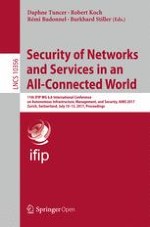1 Introduction
2 Problem Statement
2.1 Modeling and Formalization of QoE
2.2 Web QoE Metrics and Assessment
2.3 Challenges of Objective Methods for Network Related QoE
2.4 Use Cases
-
Network Providers need to optimize investments on new infrastructure in a way that costs are minimized while turnover is maximized, aiming at ultimately maximizing profit. QoE is a valid metric for customer satisfaction, which in turn we imply is positively correlated with turnover. Due to this correlation, optimizing for QoE is more target-oriented than optimizing for technical QoS parameters. The knowledge of a base level of customer satisfaction and the ability to detect changes is key either to assess the effect of investments already carried out and to identify weak points in network infrastructure that are most in need for further investments.
-
Service Providers that offer their business to worldwide customers, often rely on both own and third-party infrastructure to deliver contents. Ensuring continuous availability and convenient response times, as two key service level metrics, is business-critical to them. Their challenge in monitoring customer experience is manifold: Services are frequently added and changed so that automatic or synthetic monitoring of technical key performance indicators often lags behind and covers only a small fraction of all service functions. Also a service provider would like to be aware of a shift of customers’ experience during the lifetime of a service. Challenging is that the underlying infrastructure is very heterogeneous in most times, not only because of third-party services but also because of implementing novel cloud technologies as demanded by service expansion. In case of a problem, they also want to identify whether the problem affects only their own service or services of other providers as well to communicate accordingly to their customers.
-
Security Actors may observe disruptions of network segments or services of central importance for the reliability of internet infrastructure as a result of large-scale attacks. In such scenarios, it is crucial to gain as much information as possible as quickly as possible. This is to make up the information advantage of the attackers and become able to successfully deploy counter measures in a timely manner. To know whether, which, where and to what extend web services are affected, can support this process effectively.
2.5 Requirements
3 Related Work
3.1 Measuring QoE
3.2 Using Twitter to Detect Outages
3.3 Open Points
Requirement (see Sect. 2.5) | Casas [5] | Mok’11 [23] | Mok’16 [24] | Motoyama [26] | Qiu [27] | Augustine [3] |
|---|---|---|---|---|---|---|
1: Global baseline | 
| 
| 
| 
| 
| 
|
2: Detect score changes | 
| 
| 
| 
| 
| 
|
3: Independent of technology | 
| 
| 
| 
| 
| 
|
4: Adapt new services | 
| 
| 
| 
| 
| 
|
5: Continuous monitoring | 
| 
| 
| 
| 
| 
|
6: Results in real-time | 
| 
| 
| 
| 
| 
|
4 Internet Scale QoE Measurement
4.1 Experimental Setup
4.2 Data Source
5 Evaluation
# | Time | Event ratio | Median multiplier | Causing event |
|---|---|---|---|---|
1 | 28-Feb-17 18:30 | 0.000456 | 27.5 | Amazon S3 outage |
2 | 28-Feb-17 18:10 | 0.000424 | 25.6 | Amazon S3 outage |
3 | 28-Feb-17 18:15 | 0.000374 | 22.5 | Amazon S3 outage |
4 | 28-Feb-17 18:00 | 0.000371 | 22.4 | Amazon S3 outage |
5 | 28-Feb-17 18:25 | 0.000352 | 21.2 | Amazon S3 outage |
16 | 27-Feb-17 11:30 | 0.000275 | 16.6 | Error message on hilton.com |
24 | 02-Mar-17 10:50 | 0.000246 | 14.8 | Vainglory game server maintenance |
37 | 02-Mar-17 12:25 | 0.000204 | 12.3 | Booking problem on qatarairways.com |
42 | 27-Feb-17 12:10 | 0.000188 | 11.3 | Booking problem on klm.com |
50 | 02-Mar-17 12:35 | 0.000141 | 8.5 | Amazon S3 outage |

